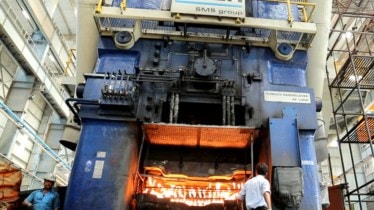Kolkata-based Ramkrishna Forgings recently announced its second acquisition in less than 7 months. This could further accelerate its target of crossing the Rs 5,000 crore revenue mark well-before FY2025.
“We had announced the Rs 5,000 crore target 5-6 quarters back. What we are looking at right now is certainly a growth of over 20 percent per annum on a standalone basis. If everything comes on plate by FY2025 the turnover will be more than Rs 5000 crore,” says Lalit Kumar Khetan, Executive Director and CFO, Ramkrishna Forgings to Financial Express.
He points out that on a standalone basis, Ramkrishna Forgings will alone make Rs 5,000 crore by FY2025. The additional revenue from JMT, ACIL and others will “further add Rs 1,000 crore.”
In terms of financial, in Q1 FY2024, it reported revenue of Rs 835 crore, up 28 percent YoY, EBITDA of Rs 187 crore at 22.4 percent margin, and net profit of Rs 76 crore versus Rs 47 crore for the same period last year.
Its focus on diversifying and international business is also bringing in smart returns. In fact, Khetan says the company currently has a capacity utilisation of around 92 percent, and it is adding capacity every quarter.
“We already announced a capacity addition of 23,000 tonnes in July. Another 33,000 tonnes will come up in the next 3 months’ time. Moreover, 25,000 tonnes is being added in cold forging by FY2025.”
Electrification and derisking
It was in December last year the company acquired a majority stake in Tsuyo Manufacturing (Tsuyo), a start-up working on electric powertrains as part of its diversification strategy. It aims to expand the product portfolio of motors, controllers, e-axles, and differentials. The idea is to keep investing around Rs 100 crore per annum over five years.
On the other hand, Ramkrishna Forgings primarily caters to the automotive industry mainly commercial vehicle, off-road highway, and tractor segments. This makes up almost 78 percent of its revenue, the rest comes from other industries. Khetan says the idea is to reach a ratio of 70:30 in the medium term.
“We are just derisking ourselves in auto and are trying to improve our presence in railways, oil and gas, off-highway and other sectors like farm equipments and few other industries. Our strategy is to derisk and become a 70:30 auto: non-auto company. At present, the domestic market is very strong but certainly, we have seen a lot of orders from overseas in the last 2 years,” he adds.
Commercial vehicle segment and targets
The commercial vehicle industry in India is seeing a smart recovery.
Outlining his expectation and targets, Khetan says “The next 2-3 years looks very good for the commercial vehicle industry, but we don’t want to predict beyond that. In fact, we would prefer to evaluate the situation every year rather. The real challenge is execution, we are looking to grow fast.”
